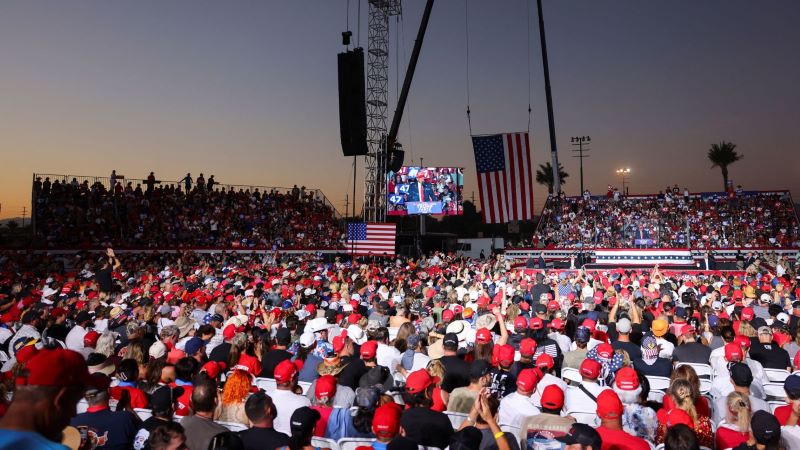In this article, we delve into the details of the Donald Trump third assassination attempt that was recently thwarted in California. Learn about the suspect, the aftermath, and Trump’s evolving stance on cryptocurrency. Stay with us to get the full story on this critical event.
Breakdown of the third assassination attempt on Donald Trump
On October 12, 2024, a third attempt to assassinate Donald Trump, the former U.S. President, was thwarted at a campaign rally in Coachella Valley, California. The suspect, Vem Miller, was apprehended by police after a routine checkpoint stop. Authorities were suspicious when they found that Miller’s vehicle had not been registered. Upon further inspection, officers discovered not only a fake press pass but also two loaded firearms and counterfeit documents such as passports and driver’s licenses.
Riverside County Sheriff Chad Bianco later addressed the media, confidently stating, “I believe we just prevented another assassination attempt.” Miller, despite his arrest, was released on a $5,000 bail but now faces charges related to illegal weapon possession. He is due to appear in court in January 2025. This incident, while serious, reflects the broader challenge facing law enforcement as they work to safeguard Trump’s public appearances, particularly in light of previous threats.

Public reaction and political responses
The news of this assassination attempt created an immediate stir, as it was the third time Trump had been targeted in just a few months. Republican Representative Matt Gaetz had previously warned of multiple assassination plots against Trump, some possibly connected to foreign actors, including groups from Iran, Pakistan, and Ukraine. Domestic threats, such as the “sovereign citizens” movement, also pose serious dangers. This extremist faction, to which Miller is believed to belong, rejects the authority of the U.S. government, making it a volatile threat to public safety.
In light of the increased dangers, President Joe Biden ordered that Trump be given the same level of security as a sitting president, underlining the importance of ensuring his safety despite political disagreements.
Impacts on Trump’s campaign events
This latest assassination attempt added yet another layer of tension to Trump’s already high-stakes campaign rallies. Security measures have been further intensified after Trump survived two similar threats earlier in the year. The Coachella incident emphasized the extent to which Trump remains a prime target, not just for lone attackers but for more coordinated efforts by extremist groups.
As Trump continues his campaign, his security team, alongside federal and local law enforcement, faces an increasingly difficult task in preventing such incidents. With extremists exploiting both traditional and digital methods to plan attacks, safeguarding Trump’s public appearances has become a challenge of unprecedented complexity.

Social and political context
The political divide in the United States has deepened, giving rise to movements that threaten public figures. One such group is the “sovereign citizens,” which Miller is believed to be affiliated with. This movement is characterized by its rejection of government authority and refusal to adhere to legal and financial obligations, such as taxes. The ideological divide represented by such movements only adds to the instability of the current political landscape.
The increase in politically motivated attacks illustrates just how dangerous the atmosphere has become. Public figures like Trump are frequently the targets of these extremist movements, further complicating an already fragile national security environment.
Trump’s shifting views on blockchain and cryptocurrency
Donald Trump has long been known for his critical stance on cryptocurrency, particularly Bitcoin. During his presidency, Trump often referred to digital currencies as a “scam” and warned of the risks they pose to the U.S. economy. He argued that cryptocurrencies, especially those not regulated by the government, were fraught with danger and instability.
However, in a notable shift, Trump recently hinted that he might take a more favorable approach to Bitcoin if re-elected. He suggested that he could “make Bitcoin great again,” signaling that, despite his earlier skepticism, he now sees potential in the blockchain technology that underpins digital currencies. Trump’s revised stance indicates a recognition that cryptocurrencies, if properly regulated, could benefit the U.S. economy.
His comments have sparked interest within the cryptocurrency community. While Trump remains cautious about fully embracing digital currencies, his statements suggest that he may be open to crafting policies that promote the responsible use of blockchain technology and cryptocurrency in the future.

The broader implications of assassination attempts and political polarization
The repeated attempts on Donald Trump’s life reveal a growing problem within the U.S. political sphere. The rise of extremist movements, coupled with increasing political polarization, has made it more difficult to ensure the safety of public figures. The ongoing threats against Trump are just one facet of a broader national security issue, which will likely continue to shape the country’s political landscape moving forward.
In conclusion, the third assassination attempt against Trump highlights the volatile political environment in which he operates. With continued threats and evolving security challenges, both federal and local authorities must remain vigilant in protecting not only Trump but all public figures who face similar risks.
The Donald Trump third assassination attempt reveals the growing threats faced by public figures in today’s polarized environment. Keep following Digicash Blog for insightful analyses on political events, security, and the latest trends in blockchain and cryptocurrency.

